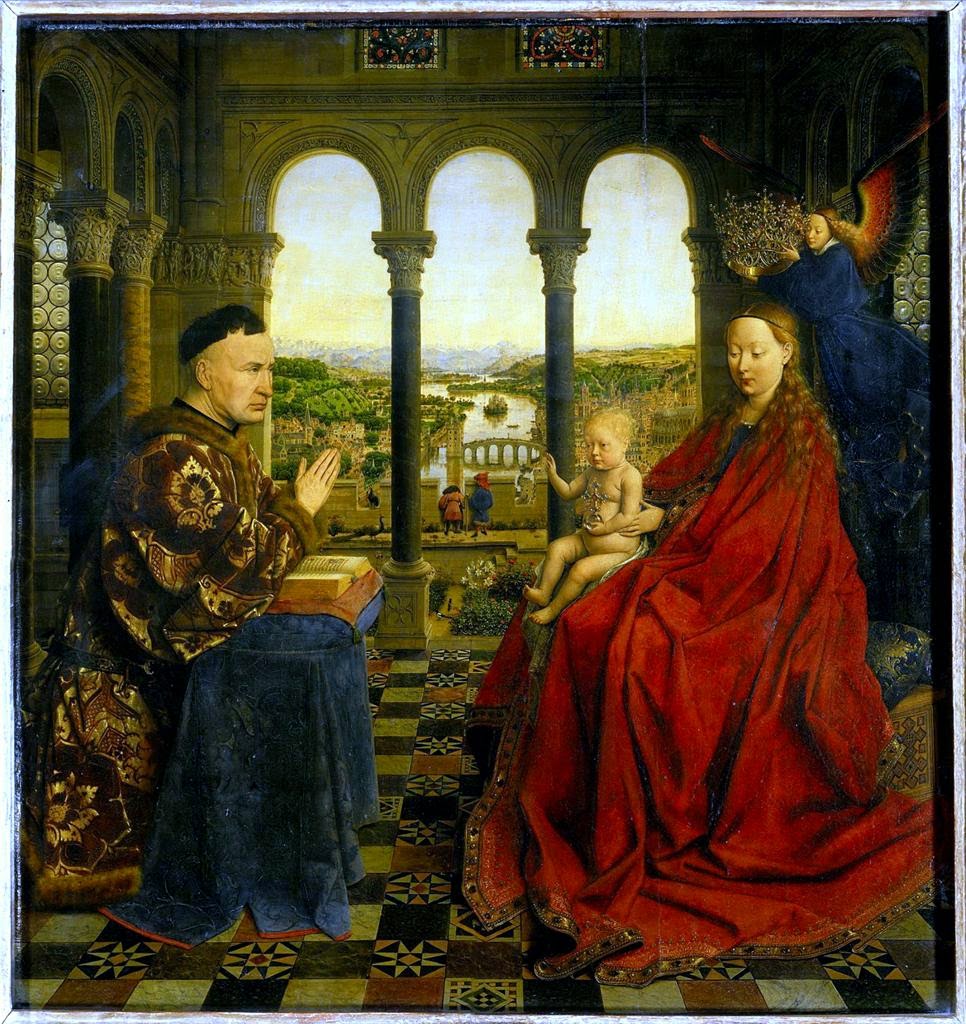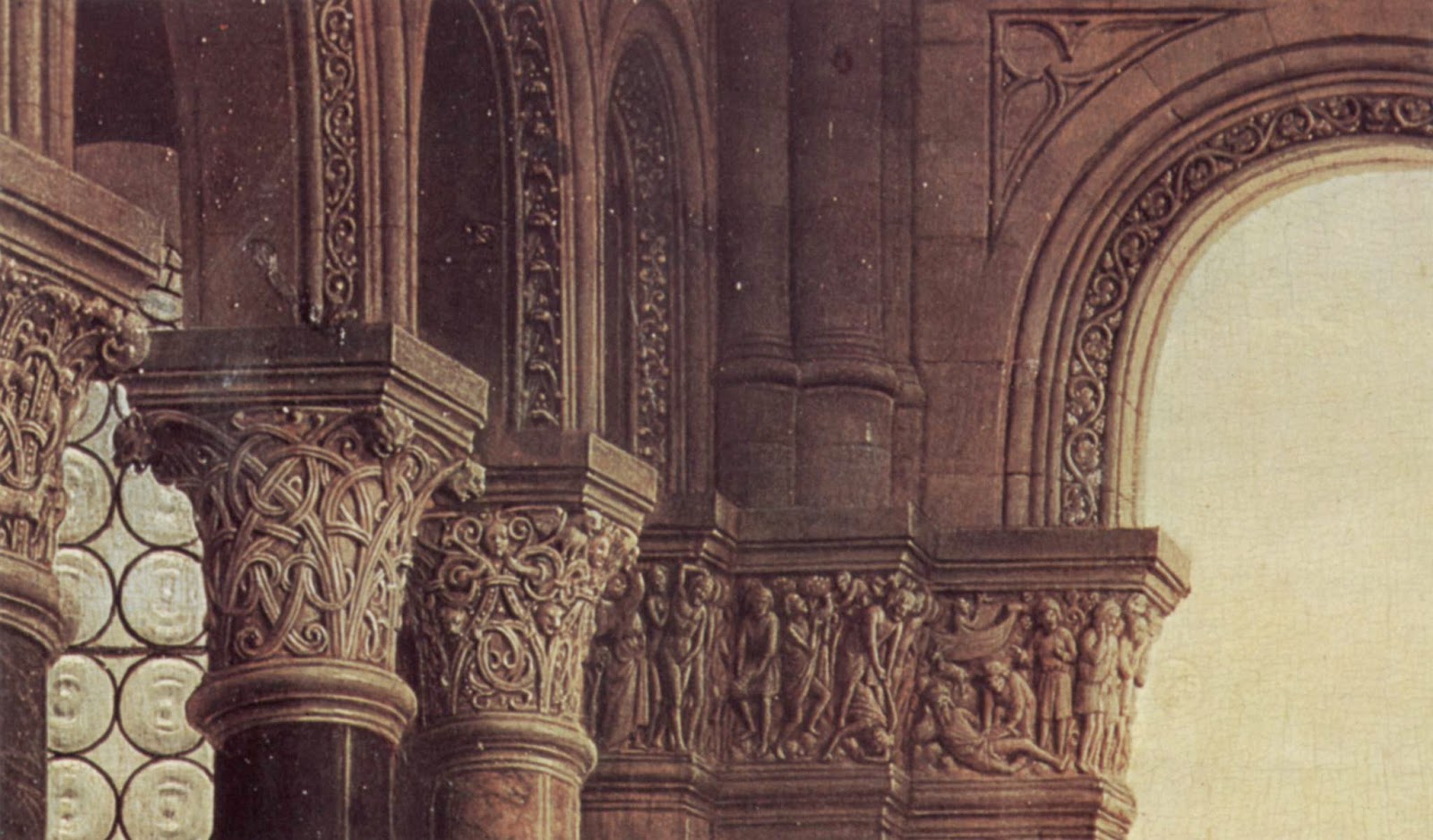Except where noted, these are all my photos and available to all, especially to educators.
A column capital from the outside of the church that shows subject matter typical of Gislebertus; ferocious demons and devils menacing Christ and other saintly figures.
The outside of the Cathedral. The current cathedral was built from 1120 to 1146 to replace an earlier Cathedral of Saint Nazare, and to house relics believed to be those of Lazarus of Bethany (the one Christ raised from the dead) acquired in 970. Autun straddled one of the main pilgrimage routes to Compostela, and the relics of Lazarus soon attracted legions of pilgrim visitors on their way to Compostela. Most of the original 12th century building survives intact, but it is encased in later gothic additions from the 15th century such as the side chapels on the nave and the tall spire over the crossing.
Inside the Cathedral of Saint Lazare at Autun
The fine barrel vaulted ceiling from the 12th century; the Cathedral had ties to the great monastery at Cluny which once had a similar barrel vault.
The apse of the Cathedral which I suspect is in part a later gothic rebuild; at least the upper story with the tall lancet windows.
The remains of the "Tomb of Lazarus" in the nearby Rolin Museum which once stood in the apse of the Cathedral and housed the relics.
The very beautiful and unusually sensitive figure of Christ from the "Tomb of Lazarus." Is this a work by Gislebertus? I doubt it. But whoever it was, it's a remarkable demonstration of the expressive range and high quality of Romanesque sculpture at its best.
Part of the articulation of the nave in the Cathedral at Autun, long regarded as a masterpiece of Romanesque architecture and engineering with arches and galleries multiplied in order to hold up the heavy stone vaulting. The Cathedral's interior is inspired by the remains of a 1st century Roman arch still to be seen in Autun.
What were once acanthus wreathed Corinthian capitals on the Roman arch are now storiated capitals carved by Gislebertus and his shop.
I'm not sure what the subject of this capital is, but it is very dramatic, and must have been even more so when it was originally brightly painted. Romanesque art is a gestural art, and rarely were those gestures more dramatic, or had such an emotional range, as the sculptures at Autun.
Another scene of confrontation between a large menacing devil with bared teeth and another saintly looking figure. I'm guessing that this is the Temptation of Christ, except that Christ here looks very small and young, and seems to be held up by an angel.
A scene that I think is the Risen Christ and Mary Magadalene with two of the Three Women at the Tomb on the right around the corner.
The magnificently seductive and serpentine figure of Eve whispering temptation, a very unusually sensual medieval nude carving by Gislebertus in the Rolin Museum. It is part of a lintel, the sole surviving portion of the north tympanum that once showed the Resurrection and the Raising of Lazarus. Clerics in the late 18th century, whose tastes were shaped by NeoClassicism and by various pietist revivals, thought these sculptures were barbaric and licentious. They destroyed a lot of Gislebertus' work and concealed a lot more under plaster. They were uncovered and restored in the 1830s with the Romantic revival of interest in medieval art.
The Flight Into Egypt
As fine as the capital sculptures are, the real tour-de-force is the tympanum over the west entrance to the Cathedral, Gislebertus' masterpiece.
The great tympanum at Saint Lazare. Gislebertus carved a frightening vision of the Last Judgement, one of the most terrifying in medieval art, as the ultimate catastrophe, a terrible final audit of accounts. The assets are weighed against the deficits to determine the final fate of each person.
The early Middle Ages saw the spirit world as very much like the one that they lived in, a battleground between God and the Devil with Christ imagined as a liege lord with absolute power over his subjects, and expecting their unquestioning loyalty. Like the feudal world people of the time lived in, the world of the spirit was one of mutual loyalties and protection by a liege lord from the roving destructive armies just over the next hill.
The immense figure of Christ that dominates the center of the whole tympanum. Gislebertus shows him as the frighteningly impassive Judge whose decisions are final with no appeal.
The section of the Blessed is the least reproduced part of this famous sculpture. At its best, it can be as inventive as the hell scene on the opposite side, and as ecstatic as the other side is tormented. Here the blessed, newly raised from their graves, hoist themselves up by the angel's robes and writhe in ecstasy.
Peter welcomes the blessed into Paradise with one hugging an angel.
The blessed in paradise with expressions of wonder and happiness
The most famous and celebrated part of this sculpture is the hell scene on the right (Christ's left), one of the most dramatic and inventive of the Middle Ages.
So much of the content of medieval hell scenes like this is preChristian. Gislebertus' devils, and the devils that haunted the imaginations of his audience, were the descendants of all those monsters people once assumed to lurk in the wild forests at night; goblins, ogres, werewolves, trolls, etc. Few places are more terrifying than a forest at night when your light goes out. The Burgundian hills around Autun are still covered in dense forest. No other artist of the Middle Ages brought those unknown-noise-in-the-nightime-forest to terrifying life more than Gislebertus.
Gislebertus' howling devils really are frightening, and must have been more so when they were originally brightly colored. Here, a very large devil throws souls into a boiling pot. The feet of others already stick out of the top of the boiling cauldron.
The Weighing of Souls is a subject that predates Christianity. We can find examples in Egyptian art. Here, a devil tries to tip the scale in his favor while another smaller howling devil stomps in the pan. An even bigger devil behind the one trying to tip the scale threatens to throw a toad in to weight it in hell's favor. The devil trying to tip the scale very casually holds a soul by the hair with his left claw.
Souls hide in terror behind the angel's robes during the weighing of souls.
A devil pops out of the mouth of another bigger devil and grabs souls by the throat.
The souls of the damned writhe in despair as their sentence is read.
One of my favorite details, a pair of disembodied clawed hands grabs a poor soul as he rises out of his tomb. A devil stands aside laughing at him on the left. Snakes suckle at breasts of the woman on the right.
The beautifully carved zodiac signs with Labors of the Months along with a remarkable open work grape vine on the inner archivolt.
Detail of the Labors of the Months with zodiac signs
Gislebertus' very proud signature right at the feet of Christ in the Last Judgement; a risen soul looks up adoringly at Christ and at Gislebertus' name. So much for the romantic image of the humble self-effacing medieval artisan, at least at Autun.
Here is my photograph of Jan Van Eyck's Madonna of Chancellor Rolin hanging in the Louvre. There is a connection between this painting and Autun and Gislebertus.
A reproduction from Study Blue
This magnificent painting was made to hang in a the Chapel of Saint Sebastien in the Church of Notre-Dame-du-Chatel at Autun where Nicholas Rolin was baptized and where his ancestors were buried. Notre-Dame-du-Chatel was torn down in 1793, and this painting entered the Louvre that same year. Nicholas Rolin's brother was the Bishop of Autun.
A detail of the Madonna of Chancellor Rolin from Wikipedia
Jan Van Eyck, like all great artists, was also a great art historian who knew the past and used it to speak to the present. The storiated capital above the head of Nicholas Rolin was clearly inspired by Gislebertus' work at Autun and shows scenes of human failure: Adam and Eve driven from Paradise, the story of Cain and Abel, and the Drunkenness of Noah.
There is another major 15th century Flemish painter who was inspired by Gislebertus' work, and who also worked for Nicholas Rolin. More about him in a later post.
My photograph of Jean-Yves Bonnamour in the Cathedral. The next four photos are his.
Jean-Yve's photo of me admiring Gislebertus' work on the west tympanum.
Jean-Yve's photo of Bill Paulsen sitting in Autun Cathedral
Jean-Yve's beautiful photo of the apse of the Cathedral
Jean-Yve's very beautiful photo of Gislebertus' Eve; He had a better camera than mine, but he's also a much better photographer than me.
CLUNY
On this same trip, we made it to Cluny in the evening, site of the largest, wealthiest, and most powerful monastery in medieval France. It was closed during the French Revolution, and most of it was demolished in the early 19th century.
This is the sole surviving part of what was once the largest and most magnificent of all Romanesque churches, the monastery church of Cluny.
Here are more remains of the nave of the once vast monastery church.
From Wikipedia, a photo of a model of the monastery at its height. The monks of Cluny came exclusively from the ranks of the French nobility. They prayed and said the Daily Office around the clock in shifts of 9 hours. The Cluniac monks answered only to the Pope and so were independent of the French Crown and French bishops. They owned miles of productive land farmed by legions of serfs and peasants who put themselves under the dominion of the monks thinking that would spare them the fires of hell. The Cluniac order maintained numerous monastic houses along the major pilgrimage routes to Compostela.
Jean-Yve's photo of Bill Paulsen and me at Cluny.









































2 comments:
That Gislebertus "Eve" is famous! (Trying to remember where I've seen it before---book covers in seminary, I think)
Splendid tour of a wonderful old church. Could the falling angel be Lucifer, the archangel gone bad?
Also, the hands on the beautiful statue of Christ seem to be out of proportion, larger than life, unless the angle of the photo distorts them.
Post a Comment